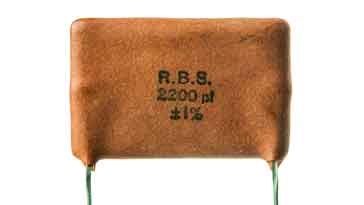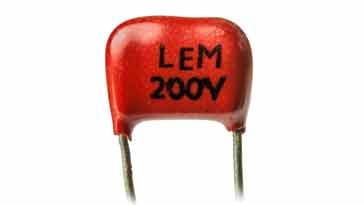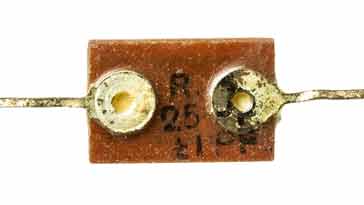Silver Mica Capacitors
Silver mica capacitors provide high precision, high Q & stable performance and are available in low values normally for use in radio frequency circuits.
Home » Electronic components » this page
Capacitor Tutorial Includes:
Capacitor uses
Capacitor types
Electrolytic capacitor
Ceramic capacitor
Ceramic vs electrolytic
Tantalum capacitor
Film capacitors
Silver mica capacitor
Super capacitor
Supercapacitor vs batteries
Surface mount capacitors
Specifications & parameters
How to buy capacitors - hints & tips
Capacitor codes & markings
Conversion table
The silver mica capacitor provides very high levels of performance with close tolerance values with low levels of value change with temperature.
In view of its performance it was the capacitor of choice for many RF designs and circuits such as oscillators, filters and anywhere that a close tolerance and low drift capacitor was needed.

Nowadays other types like ceramic capacitors are able to provide a similar level of performance in a smaller space or volume and also at a much lower cost. As a result the silver mica capacitor is an electronic component that is not widely used these days
Despite this fact, these electronic components are still available and used in a number of applications where the performance needed calls for them. They will also be encountered when repairing older radios and other existing circuits and especially older RF designs and equipment.
These capacitors have been traditionally available as leaded devices, but some silver mica surface mount capacitors are also available as specialist products.
What is a silver mica capacitor
Silver mica capacitors developed from the very early mica capacitors that were use in the early 1920s and 30s. These early mica capacitors were made by the Dubilier company and some of their Micadon capacitors can still be seen in vintage radio sets.
These capacitors were made from sheets of mica and copper foil sandwiched together and clamped - the clamps could often be seen in the construction of the capacitor.
These early mica capacitors had poor levels of tolerance and stability resulting from the imperfect service of the mica dielectric which was a naturally occurring material. References to mica capacitors from the 1920s always refers to this type.
The old mica capacitors were developed further and their performance was significantly improved to give the silver mica capacitors used more recently and even available today.
Silver mica capacitors, as the name implies use a mica dielectric which is then silvered to provide the plates or electrodes of the capacitor.
Mica is a shiny naturally occurring silicate mineral which has a layered or monoclinic structure and this means that it can be readily split into thin plates.
The material has a relatively high dielectric constant compared to many other naturally occurring layered minerals. It is typically between 5 and 7. Mica is also very stable mechanically and chemically making it a good base for electronic capacitors. The chemical stability means that the long term performance of the silver mica capacitor is particularly good.
Mica does not react with oil, water, many acids alkalis, and solvents. As a result, ageing does not occur to any major degree, and the variations of water vapour in the atmosphere do not cause undue variations in the overall capacitor performance.
Natural mica has to be carefully selected because some samples contain impurities that can degrade the performance of the silver mica capacitor. Also the sheets of mica used in capacitor manufacture are relatively thin ranging from about 0.025 to 0.1 mm.
There is a high degree of variation in the raw material as it is naturally occurring. This results in higher manufacturing costs because of the inspection, sorting and manufacturing variations required.
There are different types of mica: muscovite (excellent electrical properties) and phlogopite (high temperature resistance) mica are the most common. Mica is found in a limited number of places around the globe including India, Central Africa and South America.
Although more costly than other dielectrics, mica is an ideal form of dielectric for very high performance capacitors. A summary of the properties of mica are given below:
| Mica Dielectric Parameters | |
|---|---|
| Parameter | Value |
| Dielectric constant | 6 |
| Dielectric strength | 10 000 volts per mil |
Silver mica capacitor properties
The reason for the continued use of these electronic components, especially in some RF designs is the fact that they can offer very high levels of performance, better in many areas than any other type of capacitor. However in many applications, other more modern technologies provide levels of performance that meet the needs for that particular requirement.
The particular properties of the silver mica capacitor are summarised below:
- High accuracy: Silver mica capacitors can be obtained with tolerance figures of +/- 1%. This is much better than virtually every other form of capacitor available today.
- Temperature co-efficient: The temperature co-efficient of silver mica capacitors is much better than most other types of capacitor. The temperature coefficient is positive and is normally in the region 35 to 75 ppm / C, with +50 ppm / C being an average value. This property is useful in ensuring oscillators (and filters) do not drift unduly with temperature.
- Value range: Values for silver mica capacitors are normally in the range between a few picofarads up to two or possibly three thousand picofarads.
- Low capacitance variation with voltage : Silver mica capacitors exhibit very little voltage dependence.
- High Q : Silver mica capacitors have very high levels of Q and conversely small power factors. These are both almost independent of frequency. This is one property of the capacitors that is useful in making stable low noise oscillators, and selective filters.
Although silver mica capacitors have a high tolerance and low temperature co-efficient they are known to jump in value on occasions. When this occurs, it can cause an oscillator to jump in frequency, or a filter to change its properties.
Silver mica capacitor structure
Very early mica capacitors in the 1920s were made by physically clamping sheets of mica with copper electrodes between them. These were left open to the atmosphere. The performance of these early mica capacitors was very not surprisingly very poor, but this was improved when silver electrodes were used instead..
The current electronic components use silver electrodes that are plated directly onto the mica. Several layers are used to gain the required level of capacitance. Also the area of the electrodes has a major effect on capacitance.
Once the basic silver mica capacitor has been made, it is housed in a ceramic encapsulation which reduces ingress of moisture and other contaminants.
Silver mica capacitors are mainly available in leaded versions - a limited variety of silver mica surface mount capacitors available from a limited number of suppliers. They tend to be a more specialist product.

Those silver mica capacitors used for valve or vacuum tube radios were generally encapsulated in wax. The wax on these electronic components did tend to melt relatively easily leaving small ‘blobs’ of wax at the bottom of the radio.

Silver mica capacitor applications
Silver mica capacitors are able to provide very high levels of accuracy, stability and low loss. As a result silver mica capacitors found many uses in particular for radio frequency applications:
- Filters: The close tolerance levels of the silver mica capacitor enables the exact performance to be calculated and predicted. Also the low loss levels of the silver mica capacitor enable high Q filters to be realised.
- RF oscillators: Silver mica capacitors can fund uses within RF oscillators. In these applications their low loss levels enable the Q of the tuned circuit to be improved. This yields improved stability and lower phase noise levels. Also their low temperature coefficient enables even free running oscillators to achieve good stability levels and low drift.
- Coupling and decoupling: The cost of silver mica capacitors generally means that they are not used for coupling and decoupling, but they can withstand high voltages and this may have meant they have been used in these applications occasionally. They can be used in RF transmitters and amplifiers where their high voltage capability is utilised as cost effective ceramic or porcelain capacitors are not widely available.
Silver mica capacitor summary
The table below provides some of the salient features about silver mica capacitors that can be taken into consideration for new RF designs or general electronic circuit designs or when replacing old components in vintage radios and the like.
| Silver Mica Capacitor Summary | |
|---|---|
| Parameter | Details |
| Value range | Few pF to ~4700pF |
| Working voltage | 100V to 1kV |
| Temperature coefficient | 30 – 75ppm / °C |
| Advantages |
|
| Disadvantages |
|
 Written by Ian Poole .
Written by Ian Poole .
Experienced electronics engineer and author.
More Electronic Components:
Batteries
Capacitors
Connectors
ADC
DAC
Diodes
FET
Inductors
Memory types
Phototransistor
Quartz crystals
Relays
Resistors
RF connectors
Switches
Surface mount technology
Thyristor
Transformers
Transistor
Unijunction
Valves / Tubes
Return to Components menu . . .


